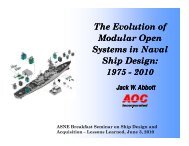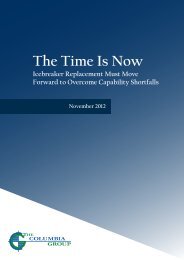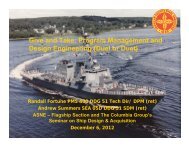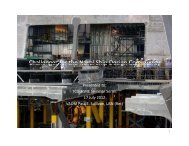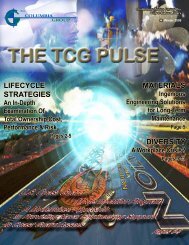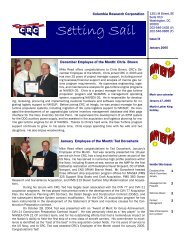Lessons Learned from the USS Stark Attack (Boulay)
Lessons Learned from the USS Stark Attack (Boulay)
Lessons Learned from the USS Stark Attack (Boulay)
You also want an ePaper? Increase the reach of your titles
YUMPU automatically turns print PDFs into web optimized ePapers that Google loves.
•The Germans in WWII were <strong>the</strong> first to use ASCMs.<br />
•In 1967, Egypt sunk <strong>the</strong> Israeli destroyer Eilat with four Styx ASCMs. Egypt fired <strong>the</strong> missiles <strong>from</strong><br />
missile boats supplied by <strong>the</strong> Soviet Union.[vii]<br />
•During <strong>the</strong> Falklands War (1982), four Argentine Navy Super Etendard fighters sunk a British Type<br />
42 destroyer and a support ship, <strong>the</strong> Atlantic Conveyor, with Exocet missiles. A land-based Exocet<br />
missile also struck <strong>the</strong> Royal Navy's HMS Glamorgan, but maneuvers made by <strong>the</strong> Glamorgan<br />
minimized damage to <strong>the</strong> ship.[viii]<br />
•During <strong>the</strong> tanker war, Iran and Iraq used anti-ship missiles in more than half of all attacks on<br />
shipping. Iraq used missiles in approximately 80 percent of <strong>the</strong>ir attacks on commercial ships.<br />
•The U.S. Navy used Harpoon missiles to sink an Iranian patrol boat, Joshan, during Operation<br />
Praying Mantis in 1988.<br />
•In Operation Desert Storm, Iraqis fired a Silkworm missile in <strong>the</strong> Gulf. The Silkworm was intercepted<br />
and destroyed by a Sea Dart missile launched by HMS Gloucester.<br />
•In 2006, Hezbollah fired a radar-guided[ix] C-802 at <strong>the</strong> Hanit, an Israeli corvette. Four Israeli sailors<br />
were killed and <strong>the</strong> Hanit sustained significant damage. An additional C-802 missile fired at <strong>the</strong><br />
corvette missed, striking a nearby Cambodian-flagged merchant ship.[x]<br />
•Tanker War/Iran Iraq War In Gulf – COMIDEASTFOR – LaSalle + 6 old DDG’s/FFG’s<br />
•Cold War – last stages (Berlin wall 9 November 1989)<br />
•Closest CV – Med/China Sea<br />
•Saudi ports unavailable/ Bahrain and Dubai only ports allowed. Refueled on south side of<br />
Oman <strong>from</strong> anchor.<br />
1
Evening of May 17 1987 approximately 2200 local time<br />
•<strong>Stark</strong> Underway in <strong>the</strong> Sou<strong>the</strong>rn Operation Area<br />
•Approved to conduct engineering casualty control drills<br />
•Combat systems online in modified condition 3<br />
•CIWS secured<br />
•O<strong>the</strong>r systems in standby – 50% of condition 1 manning<br />
•“Operations Normal” in Gulf<br />
•2 ships on station, 4 in Bahrain, 1 in North Arabian Sea<br />
•Coontz, LaSalle allognside pier<br />
•Conyngham, Waddell at inner anchorage<br />
•Reid operating outside straits of Hormuz<br />
•Saudi AWACS/F-14’s (2) on station<br />
•Iran Shuttle Tankers making runs<br />
•Iraq Ship <strong>Attack</strong> Profile (SAP) activity underway<br />
2
•Representation <strong>from</strong> memory of operations chart for May 1987 in MEF.<br />
•Red line marked <strong>the</strong> Eastern/Nor<strong>the</strong>rn limits of operations<br />
•Black lines show track of F-8 Mirage as reported by AWACS<br />
•Red “X” marks <strong>Stark</strong>s position when attacked.<br />
<strong>Stark</strong> had received operations rules of engagement (ROE) and intelligence threat briefs <strong>from</strong><br />
Commander, Middle East Force (COMIDEASTFOR) in Djibouti on February 28, prior to arrival in <strong>the</strong><br />
<strong>the</strong>atre of operations. The ROE brief counseled conservative action and <strong>the</strong> potential threat to U.S.<br />
Navy ships in <strong>the</strong> Persian Gulf. The brief stated that <strong>the</strong> probability of a deliberate attack on a U.S.<br />
warship was low, but that an indiscriminate attack in <strong>the</strong> Persian Gulf was a significant danger. <strong>Stark</strong><br />
entered <strong>the</strong> Gulf in early March, conducting patrol operations in both <strong>the</strong> nor<strong>the</strong>rn and central Gulf for<br />
a period of approximately eight weeks. During this time, <strong>the</strong>re were several visible missile attacks on<br />
foreign flag vessels, but <strong>Stark</strong> was never threatened. <strong>Stark</strong> was also preparing for an upcoming<br />
operational propulsion plant examination (OPPE) and had started to conduct drills and speed trials<br />
during periods of time <strong>the</strong> CO deemed safe to do so.<br />
No Higher Honor: Bradley Peninston 2006<br />
3
MIRAGE F-1<br />
Length: 4.69 m<br />
Diameter: 0.35 m<br />
Launch Weight: 670.00 kg<br />
Payload: 165 kg HE, fragmentation<br />
Propulsion: Solid<br />
Range: 70.00 km<br />
Guidance: INS, active radar<br />
The AM-39 Exocet is a short-range, solid propellant, single<br />
warhead, air-launched, anti-ship cruise missile developed and<br />
manufactured by France. Several hundred were fired in combat<br />
during <strong>the</strong> Falklands conflict and <strong>the</strong> Iran-Iraq War in <strong>the</strong> 1980’s.<br />
Iraq launched over 100 missiles against Iran during Iran-Iraq War<br />
between 1980 and 1988<br />
4
“At 2109 on <strong>the</strong> night of May 17, <strong>the</strong> port bridge wing lookout sighted a glow that appeared inbound<br />
<strong>from</strong> <strong>the</strong> horizon. The seaman called, "Missile il inbound, missile il inbound," on <strong>the</strong> sound powered<br />
circuit. This information was passed into <strong>the</strong> bridge and <strong>the</strong> JL phone talker in CIC, but not to <strong>the</strong><br />
tactical action officer (TAO) in CIC. The junior officer of <strong>the</strong> deck (JOOD) also sighted <strong>the</strong> missile just<br />
before it struck <strong>the</strong> portside of <strong>Stark</strong> below <strong>the</strong> bridge at frame 110. General quarters was sounded<br />
almost simultaneously with <strong>the</strong> first hit. The JOOD <strong>the</strong>n observed a second missile inbound, grabbed<br />
<strong>the</strong> 1MC and announced, "Inbound missile, port side." At 2110, <strong>the</strong> second Exocet missile hit <strong>Stark</strong> in<br />
<strong>the</strong> same location as <strong>the</strong> first. The first missile which did not detonate, instead disintegrated, parts of<br />
which passed through <strong>the</strong> starboard side of <strong>the</strong> ship at frame 172. The warhead was found later on<br />
<strong>the</strong> second deck at frame 171. The second missile exploded about three feet inside <strong>the</strong> skin of <strong>the</strong><br />
ship”.<br />
USN Damage Control Museum<br />
5
“The explosion, blast and fragmentation of <strong>the</strong> second warhead caused severe structural damage to<br />
<strong>the</strong> ship's hull, bulkheads and superstructure on <strong>the</strong> port side at frame 110. The shrapnel and blast<br />
also caused catastrophic damage inside <strong>Stark</strong> between frames 100 and 140, destroying watertight<br />
integrity, cracking arresting stakes, compromising fire boundaries and severing <strong>the</strong> port firemain<br />
which immediately started to flood <strong>the</strong> ship and create a list to port. Each missile injected<br />
approximately 300 pounds of propellant into <strong>the</strong> berthing complex. The combustion of <strong>the</strong> burning<br />
propellant resulted in a near instantaneous heat release of 12 million BTUs, which caused a rapid<br />
<strong>the</strong>rmal pulse seldom seen in normal fires. The fire reached "flashover" in less than one minute.<br />
(Flashover is a condition whereby overhead temperatures reach 1400-1500º F. When heat is this<br />
intense, all combustible materials burst into flames and fire engulfs <strong>the</strong> space.) The majority of <strong>the</strong><br />
casualties (25) occurred in ship's control berthing.<br />
As <strong>the</strong> surviving crewmembers scrambled to escape <strong>the</strong> berthing spaces, several donned EEBDs<br />
and all proceeded to <strong>the</strong>ir practiced egress routes. Five men went through <strong>the</strong> hole in <strong>the</strong> skin of <strong>the</strong><br />
ship on <strong>the</strong> port side and were later picked up. All had used EEBDs before going ginto <strong>the</strong> water. All<br />
o<strong>the</strong>r survivors used designated egress routes. Later inspection revealed five men were killed in<br />
combat systems berthing and three in chief quarters berthing. “<br />
USN Damage Control Museum<br />
6
“Casualties suffered as a result of <strong>the</strong> explosion significantly depleted <strong>the</strong> fire teams. In fact, both<br />
repair party leaders, number 1 hose operators and investigators for Repair 2 and 3 had been killed in<br />
<strong>the</strong> first moments of <strong>the</strong> conflagration. Strong leadership at <strong>the</strong> department head level and <strong>the</strong> solid<br />
professionalism of <strong>the</strong> crew drove <strong>the</strong> remaining crewmembers to continue battling <strong>the</strong> fires. At 0134,<br />
May 18, <strong>USS</strong> Waddell arrived on scene to provide medical and damage control supplies.”<br />
USN Damage Control Museum<br />
A Dutch salvage tug initially rendered assistance <strong>from</strong> <strong>the</strong> undamaged starboard side,<br />
providing large amounts of water through three on deck “monitors” but did not offer<br />
manpower. It left <strong>Stark</strong>’s side before first light due to concern that <strong>Stark</strong> would sink, capsize<br />
or explode. She returned later after fires were under control and this photo was taken at that<br />
time.<br />
Conyngham arrived at 0200.<br />
“As morning dawned, it became very clear that <strong>Stark</strong>'s exhausted crew, having mounted a<br />
determined and persistent fight, was now too worn out and depleted to continue without assistance.<br />
Teams <strong>from</strong> Waddell and Conyngham moved aboard.” - USN Damage Control Museum<br />
I went aboard approximately 0400. Waddell had left behind 12 firefighters and by <strong>the</strong> time I<br />
arrived approximately 20 Conyngham sailors were already aboard. Over time approximately<br />
120 Conyngham sailors boarded <strong>Stark</strong> to assist in firefighting, dewatering, and recovery.<br />
7
O<strong>the</strong>r problems<br />
- Unexploded warhead discovered at bulkhead to Chief’s berthing.<br />
- investigators (killed)<br />
- No plotting of damage (DCC abandoned)<br />
- Rough stability estimate ---”Critical Angle” of list determined to be 18 degrees<br />
- Rate of increase of list: .5 degrees/hour.<br />
- all but a handful of <strong>Stark</strong> Sailors onboard<br />
- Dissimilar equipment<br />
- I order firefighting to cease and dewatering to commence as ONLY priority.<br />
- “Desert Duck” (SH3) begins to ferry men and supplies ----- flight deck cleared into smoke filled<br />
hanger for helo ops – had to stage some through DDG-17<br />
8
Lost CIC<br />
Fire Stopped on Bridge<br />
Portable pumps maintaining dewatering effort<br />
Magazine emptied<br />
Warhead isolated<br />
Corner turned about 1000<br />
<strong>USS</strong> LeSalle and <strong>USS</strong> Reid join about 1100 – Fire under control, list reducing<br />
Relieved as OIC onboard <strong>Stark</strong> about Noon by COMIDEASTFOR COS<br />
9
Fire out at 1400<br />
Reflashes for 18 hours<br />
1700 Conyngham takes <strong>Stark</strong> under tow to Bahrain – no way to pay out anchor chain. Tow with<br />
nylon hawser alone.<br />
Overnight and well into morning: recovery of remains – details gruesome<br />
Firefighting continues overnight<br />
<strong>Stark</strong> crewed by Coontz/ Conyngham sailors<br />
Arrive mid morning…….slight port list, fire completely l out.<br />
Highlights ----DDG-17 stats only - awarded Navy Unit Commendation for rescue, 1 LOM, 2 MSM’s,1<br />
NMCM, 20+ NCM’s, 15+ NAM’s, 20+ Letters of Commendation<br />
LOM to CO Conyngham for actions as on scene commander<br />
NMCM – awarded to sailor who caught shipmate falling into inferno <strong>from</strong> bridge wing while himself<br />
using a fire hose to keep <strong>from</strong> both falling through hole.<br />
MSM – one awarded to sailor who volunteered to enter flooded ships control berthing and hold in<br />
place an electrical submersible pump which would not take a suction any o<strong>the</strong>r way.<br />
Note: space at <strong>the</strong> time contained remains of 25 sailors, integrity of wire carrying 450V power could not be guaranteed as it<br />
was repeated lowered and hoisted through jagged metal rimmed hole.<br />
MSM – Awarded XO Conyngham for actions as OIC of R&A teams on <strong>Stark</strong> <strong>from</strong> 0400 to 1400 18<br />
May.<br />
<strong>Lessons</strong> learned: OBA lasts 20 min max as this is <strong>the</strong> absolute limit of personnel exposure in <strong>the</strong> face<br />
of a 1500-2000 deg F fire. Used 95% of OBA canisters in MEF.<br />
The U.S. Navy needed to refresh inventories of DC lockers. Needs include better access<br />
tools.<br />
10
Clockwise <strong>from</strong> Top Left:<br />
Portside main deck looking aft <strong>from</strong> wea<strong>the</strong>rbreak<br />
Portside bridge wing looking down <strong>from</strong> interior of bridge<br />
Portside exterior hull below main deck looking aft<br />
Externally visible damage<br />
Casualties – 3 Chief Petty Officers, 32 Men onboard<br />
2 Men Lost overboard (one body recovered)<br />
Seriously Wounded – 5 Men<br />
Rescued <strong>from</strong> Sea – 5 Men<br />
Summary of important <strong>Lessons</strong> learned<br />
- OBA in use at that time inadequate<br />
- Fleet wide compatibility of fittings and equipment<br />
- Need for “jaws of life” type equipment<br />
- Traditional 3 position nozzle ineffective – low volume spray worthless<br />
- Amount of water required to fight modern weapons induced fires excessive<br />
- Critical need to upgrade firefighting gear/clothing<br />
11





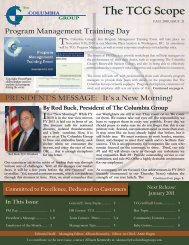

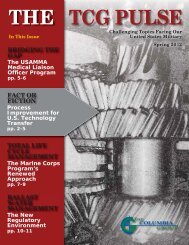

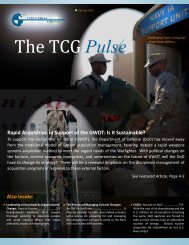
![[x] amendment of solicitation/modification of contract - The Columbia ...](https://img.yumpu.com/26856860/1/190x245/x-amendment-of-solicitation-modification-of-contract-the-columbia-.jpg?quality=85)
